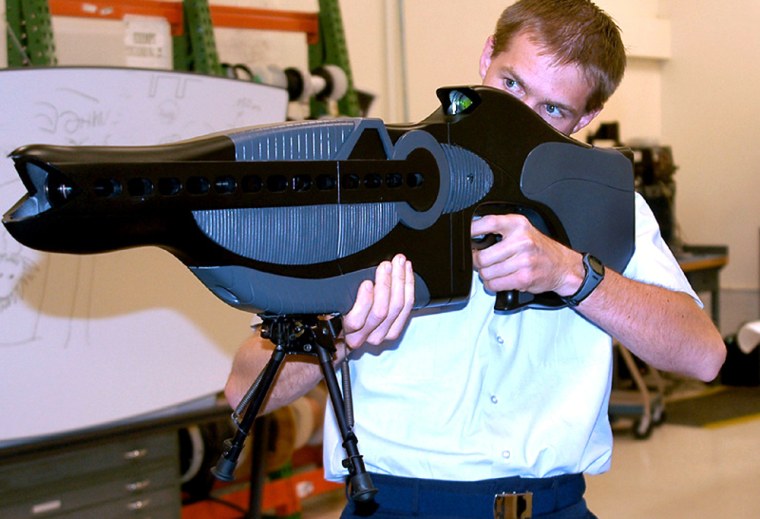It’s the stuff of fiction. A hand held laser weapon with the Star Trek moniker “PHaSER,” developed by the Air Force as a non-lethal weapon capable of being used on the battlefield or on the mean streets of any major city.
Think more along the lines of Buck Rogers rather than a Star Wars Jedi light saber.
The “Personal Halting and Stimulation Response” (PHaSER) bears as much resemblance to the Star Trek phaser as a Volkswagen does to an M1 Abrams battle tank. Air Force researchers refer to the device as “man portable,” because the prototype takes two arms to cradle and no small amount of heft to raise it to the shoulder and fire.
Using a two-wavelength laser system — the details of which Air Force researchers declined to discuss — the weapon is intended to temporarily blind an attacker. The Air Force calls it “dazzling” a suspected bad guy.
“When you 'dazzle’ an individual with laser light, it’s pretty much the same effect as if someone shines a flashlight in your eyes,” said Maj. Monte Anderson, project leader at ScorpWorks, an internal division within the Air Force Research Laboratory’s Directed Energy Directorate. “The brightness and intensity of the light is so much that it obscures your vision and you can’t see,” Anderson said. “The intent is to obscure the adversary’s vision so they can’t make you a target.”
So far about $900,000 has gone into developing two working prototypes, said Capt. Thomas Wegner, PHaSER’s program manager. The National Institute of Justice, the law enforcement arm of the Justice Department, provided funding in addition to military money, Wegner said.
In 1995 the United Nations adopted Protocol IV of the Geneva Convention that specifically banned the use of laser devices on the battlefield designed to cause permanent blindness. The United States was not a signatory to that protocol; however, then Secretary of Defense William Perry pledged that the U.S. would still abide by dictates of that protocol. “Meaning that we cannot intentionally cause blindness with a directed energy weapon,” Anderson said. “PHaSER meets Protocol IV requirements.”
Currently the device must be accurately dialed in; too close and PHaSER will blind; too far and PHaSER might as well be an oversized laser pointer. However, the second generation prototype now being built, with the help of $250,000 from the National Institute of Justice, will have “an eye-safe laser ranger finder so we can range the target and then adjust the power level accordingly so that the maximum safe energy is put on target,” Anderson said.
Small catch: it is possible to potentially defeat PHaSER by whipping out the too-hip-it-hurts laboratory equivalent of Ray Ban sunglasses to deflect the laser beam. PHaSER’s creators aren’t deterred.
“PHaSER helps you determine intent,” Anderson said. Think of conventional guns and bullets, he said. If you see a bad guy sporting a bulletproof vest that’s a pretty good indication of his intent and you act appropriately, Anderson said. Using PHaSER in the field is no different.
“If you have someone that’s a troublemaker and you decide to use non-lethal force on him and you use PHaSER and he pulls out a pair of laser eye protection, you’ve determined his intent,” Anderson said.
Don’t look for your local cops to have PHaSER slung over their shoulder any time soon. It could take another five years before PHaSER moves through all the appropriate testing and budgetary request cycles inside the Pentagon, Anderson said.
Or the whole project could simply be set to stun and never see any practical use at all. “That’s absolutely true,” Anderson said. “We build the prototypes here in the lab and then it goes to other people to test it and figure out how to use it.”
